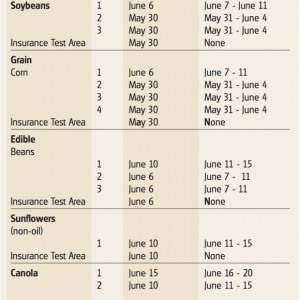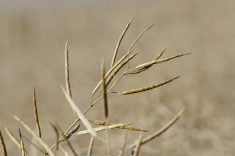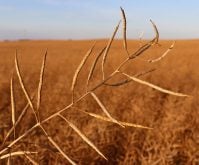The crop insurance eligibility clock is ticking away as farmers scramble to get their acres sown before the deadlines for full coverage pass.
Time has all but run out for grain corn and soybean acres. Depending on what part of Manitoba you’re in, the deadline for planting corn and soybeans and still get full coverage is as early as Friday, May 30. And there won’t be any deadline extensions.
“A big review was done in the 1990s and since then the Excess Moisture Insurance program was developed and we provide extended (planting) periods based on agronomics so there is no talk of extending anything at this point in time,” David Koroscil, Manitoba Agricultural Services Corporation (MASC) manager of insurance projects and sales, said in an interview May 23.
Read Also

Journal pulls long-cited glyphosate study for ethics violations
The journal Regulatory Toxicology and Pharmacology has retracted a 2000 Monsanto-linked glyphosate review, drawing new scrutiny as Bayer faces mounting legal pressure.
A cool and wet spring has delayed seeding for the second consecutive year.
- More from the Manitoba Co-operator: Cold, soggy spring delaying seeding on the Prairies
Deadlines for planting sunflowers, edible beans, triticale and depending on the location, canola, are not far off either. See chart further down for a full list of deadlines.
Farmers in Canola Area 1 must sow the oilseed crop by June 15 to get full coverage and by June 20 for coverage at 80 per cent.
The Canola Area 2 deadline is June 10 for full coverage and June 15 for reduced coverage.
Farmers in a very small portion of south-central Manitoba have until June 6 to seed both soybeans and corn and be fully covered. June 11 is the extended deadline with reduced coverage in Soybean Area 1 and Corn Area 1.

Friday, May 30 is the planting deadline for full soybean and corn coverage in Area 2. Farmers in Area 2 can plant both crops until June 4 with a 20 per cent decrease in coverage.
May 30 is also the deadline for seeding corn in Areas 3 and 4 and the test area, which is the rest of agro-Manitoba.
Farmers can still get full coverage on wheat, barley, oats and flax if they seed by June 20.
The reduced coverage deadline for greenfeed is July 15.
Canola seeded by air can potentially be insured so long as “it is incorporated into the soil by mechanical means and the crop establishes to a level that is equal to or greater than the insured producer’s coverage,” MASC’s website states.
“The incorporation date will be deemed to be the seeding date, with all aerial seeded acreage required to be reported on the Seeded Acreage Report by June 22.”
Farmers unable to seed due to wet fields are eligible for compensation under the Excess Moisture Program (EMI). It pays eligible farmers at least $50 an acre, less a minimum five per cent deductible. So for example, if a farmer had a 1,000-acre farm and all of it was too wet to seed that farmer would be paid on 950 acres, Koroscil said.
The EMI deductible increases by five per cent following each year the farmer makes a claim and declines by the same amount to a minimum of five per cent following claim-free years.
Farmers can buy down their deductible and pay a fee to increase their coverage to $75 of $100 an acre, but must do so by Nov. 30 the year before spring seeding.
Some farmers who didn’t get around to doing it last year have signed up now to boost EMI coverage for 2015, realizing they might be too busy to think about it this fall, Koroscil said.
As of early last week, seeding was still delayed due to wet fields in the southwest, northwest and southeast.
Hot, windy weather May 23 and 24 was welcome, but showers Sunday and more forecast for this week, threatened to further delay field work.
With almost three weeks left until the final June 20 seeding deadline, MASC isn’t hazarding a guess as to how many acres might go unseeded in 2014 due to excessive moisture, said David Van Deynze, manager of claim services.
Last year 219,241 insured crop acres were too wet to plant by June 20, he said. That was almost double the 117,623 acres unseeded in 2012.
The record was three million acres set in 2011. That year there was extensive flooding along the Assiniboine and Souris rivers and around Lake Manitoba.
Some industry observers have predicted Manitoba farmers might plant as many as 1.5 million acres of soybeans this year, up from a record 1.05 million set last year.
Manitoba still has the potential to see a large number of soybean acres seeded in 2014 despite the looming deadline, said Kristen Podolsky, production specialist, with the Manitoba Pulse Growers Association. Much depends on this week’s weather. But she also noted that most soybean plantings will occur in the central region, where planting is more advanced.
Last year only 2.1 per cent of the soybean acres seeded in Manitoba were in the new crop insurance test area, Podolsky said.
Crop insurance data shows in 2013, 55 per cent of the insured soybeans were planted in the central region.

















